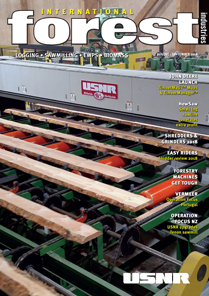EDITOR’S COMMENT ISSUE 65 OCT/NOV 2018
US making up for slower China
Though not necessarily a barometer for the whole industry, softwood export numbers released recently, combined with more general economic data, suggest a positive outlook for the forestry space. At least for now.
Numbers from the Wood Resources Quarterly (WRQ) indicated 2018 was likely to be another year of growth for the sector, despite threats coming from US President Donald Trump’s escalating trade war with China (and the rest of the world, to a lesser extent).
“Worldwide trade of lumber inched up again in early 2018, hinting that this may be another record year,” Wood Resources International, publisher of the WRQ, stated.
“Six of the 10 largest lumber-exporting countries in the world have increased their shipments in 2018, with exports from Russia, Germany, Ukraine and Austria increasing the most year-over-year.”
As we all know, demand for raw materials such as wood is dictated by global growth and the need to build new cities and houses and replace old ones.
Much of this growth is coming from the US, which is more than making up for a slowdown in China. Much has been made of the influence of Chinese growth, and rightly so, but, for now, the world’s largest economy is proving itself very much the heavyweight.
While China’s economy, currently worth around $12 trillion, has slowed gradually from 6.7% in 2016 to a projected 6.6% this year, the US economy has risen rapidly to see growth of almost 3% to its $20 trillion economy projected this year from 1.5% in 2016. That means a theorised loss of global economic scale valued at $120 million based on falling Chinese growth, against a gain in global economic scale of $280 billion on the back of rising US growth.
To put this in a slightly different light, the purchasing manager’s index (PMI), a guide to commodity demand, in China over September fell from 51.3 to 50.8 (anything over 50 signals growth). The PMI in the US, meanwhile, jumped from 59.8 to 61.3.
And it’s not just the US, several other heavyweights have posted positive PMI figures that suggest growing demand for forestry products. Japan is growing at 52.5, Germany at 53.7 and Britain was stronger still at 53.8.
This contradicts the view most us might see when we flick on the evening news, which rattles through headlines of trade wars and embattled economic outlooks in Europe centred on the Brexit debacle.
Not everyone has benefitted. Canada was hurt sharply by Trump’s ‘America First’ policies that stunted exports to its southern neighbour and it has more gradually suffered through the slowing down of China.
“The biggest decline in exports year-on-year has been from Canada, with shipments in 2018 on pace to be the lowest in five years,” the WRQ said. “Canadian shipments to China and the US during the first half of this year were down 19% and 6% respectively, as compared to the same period in 2017.”
As speculated in the last edition of International Forest Industries, however, this may be set to turn around as China cuts back on US-sourced forestry products, which it will need to replace from somewhere.
Sadly, we feel this (mostly) positive growth data may be short lived, as the medium-term effects of a trade war on global growth begin to overshadow short-term wins in the US.
Enjoy
Chris Cann





